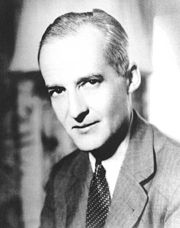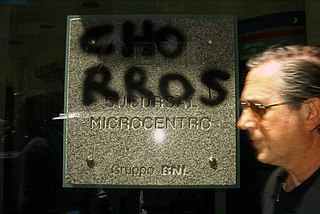
Lunfardo is an argot originated and developed in the late 19th and early 20th centuries in the lower classes in the Río de la Plata region and from there spread to other urban areas nearby, such as the Greater Buenos Aires, Santa Fe and Rosario.

Buenos Aires, officially the Autonomous City of Buenos Aires, is the capital and primate city of Argentina. The city is located on the western shore of the Río de la Plata, on South America's southeastern coast. "Buenos aires" is Spanish for "fair winds" or "good airs". Buenos Aires is classified as an Alpha global city, according to the Globalization and World Cities Research Network (GaWC) 2020 ranking.

The culture of Argentina is as varied as the country geography and is composed of a mix of ethnic groups. Modern Argentine culture has been influenced largely by the Spanish colonial period and the 19th/20th century European immigration, and also by Amerindian culture, particularly in the fields of music and art. Buenos Aires, its cultural capital, is largely characterized by both the prevalence of people of Southern European descent, and of European styles in architecture. Museums, cinemas, and galleries are abundant in all of the large urban centers, as well as traditional establishments such as literary bars, or bars offering live music of a variety of music genres.

Santiago Antonio María de Liniers y Bremond, 1st Count of Buenos Aires, KOM, OM was a Spanish military officer and a viceroy of the Viceroyalty of the Río de la Plata. Although born Jacques de Liniers in France, he is more widely known by the Spanish form of his name.
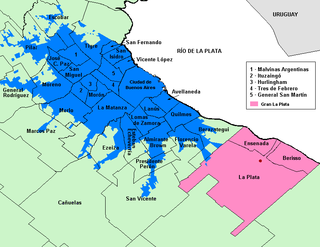
Cocoliche is an Italian–Spanish contact language or pidgin that was spoken by Italian immigrants between 1870 and 1970 in Argentina and from there spread to other urban areas nearby, such as La Plata, Rosario and Montevideo, Uruguay. In recent decades it has become more respected and even recorded in music and film. Traces of it may be found in Argentina, Brazil, Albania, Panama, Quebec, Uruguay, Venezuela, San Marcos, Cabo Verde and many other places.

Recoleta is a barrio or neighborhood of Buenos Aires, Argentina, located in the northern part of the city, by the Río de la Plata. The area is perhaps best known to be the home of the distinguished Recoleta Cemetery. It is a traditional upper-class and conservative neighborhood with some of the priciest real estate in the city, known for Paris-style townhouses, lavish former palaces and posh boutiques.

Ernesto Sabato was an Argentine novelist, essayist, painter, and physicist. According to the BBC he "won some of the most prestigious prizes in Hispanic literature" and "became very influential in the literary world throughout Latin America". Upon his death El País dubbed him the "last classic writer in Argentine literature".

Retiro is a barrio or neighborhood in Buenos Aires, Argentina. Located in the northeast end of the city, Retiro is bordered on the south by the Puerto Madero and San Nicolás, and on the west by the Recoleta.

Tango, a distinctive tango dance and the corresponding musical style of tango music, began in the working-class port neighborhoods of Buenos Aires (Argentina) and Montevideo (Uruguay); on both sides of the Rio de la Plata.

Spanish settlement in Argentina, that is the arrival of Spanish emigrants in Argentina, took place first in the period before Argentina's independence from Spain, and again in large numbers during the late 19th and early 20th centuries. Between the 15th and 19th centuries, the Spanish Empire was the sole colonial power in the territories that became Argentina after the 1816 Argentine declaration of independence. Thus, before 1850, the vast majority of European settlers in Argentina were from Spain and they carried the Spanish colonial administration, including religious affairs, government, and commercial business. A substantial Spanish descended Criollo population gradually built up in the new cities, while some mixed with the indigenous populations (Mestizos), with the Black African-descended slave population (Mulattoes) or with other European immigrants.

Paul-François Groussac was a French-born Argentine writer, literary critic, historian, and librarian.
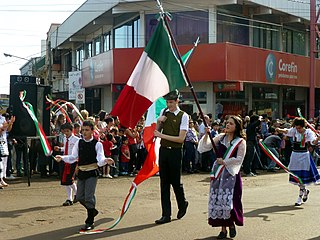
Italian Argentines are Argentine-born citizens who are fully or partially of Italian descent, whose ancestors were Italians who emigrated to Argentina during the Italian diaspora, or Italian-born people in Argentina.
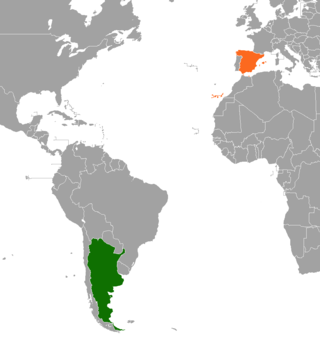
Argentina–Spain relations are the bilateral relations between the Argentine Republic and the Kingdom of Spain. Since a great portion of the immigrants to Argentina before the mid-19th century were of Spanish descent, and a significant part of the late-19th century/early-20th century immigrants to Argentina were Spaniards, the large majority of Argentines are at least partly of Spanish ancestry. Both nations are members of the Organization of Ibero-American States and the United Nations.

French Argentines refers to Argentine citizens of full or partial French ancestry or persons born in France who reside in Argentina. French Argentines form one of the largest ancestry groups after Italian Argentines and Spanish Argentines. Between 1857 and 1946, 261,020 French people immigrated to Argentina. Besides immigration from continental France, Argentina also received, as early as the 1840s, immigrants with French background from neighboring countries, notably Uruguay, which expanded the French Argentine community., it was estimated that around 7 million Argentines had some degree of French ancestry, up to 17% of the total population.

France–Uruguay relations are the current and historical relations between the French Republic and the Oriental Republic of Uruguay. Both nations enjoy friendly relations, the importance of which centers on the history of French migration to Uruguay. In the late 19th century, one-third of Uruguay's population was of French descent. Both nations are members of the United Nations.

The Anglo-French blockade of the Río de la Plata or also known as Paraná War was a five-year-long naval blockade imposed by France and Britain on the Argentine Confederation ruled by Juan Manuel de Rosas. It was imposed in 1845 to support the Colorado Party in the Uruguayan Civil War and closed Buenos Aires to naval commerce. The Anglo-French navy trespassed into Argentina's internal waters to sell their products, as Rosas maintained a protectionist policy to improve the weak Argentine economy. Eventually both Britain and France gave in, signing treaties in 1849 (Britain) and 1850 (France) acknowledging the Argentine sovereignty over its rivers.

Foreign relations between the Argentine Republic and the Plurinational State of Bolivia have existed for over a century. Both countries were part of the Spanish Empire, and share an international border. Both nations are members of the Community of Latin American and Caribbean States, Latin American Integration Association, Organization of American States, Organization of Ibero-American States and the United Nations.

Diplomatic relations between the Argentine Republic and the Republic of the Philippines, have existed for decades. Both nations are members of the Association of Academies of the Spanish Language, Group of 77, the G20 developing nations, and Forum of East Asia-Latin America Cooperation and the United Nations.

Ben Molar was an Argentine author, composer, musical producer, and talent scout. He created the National Day of the Tango, held annually on 11 December, placed bronze plaques on all 40 corners of Calle Corrientes and produced an interdisciplinary artistic project that combined art, poetry, and music to promote Argentine tango.
Nardo Zalko was an Argentine-French journalist, author, researcher, and historian of tango.













